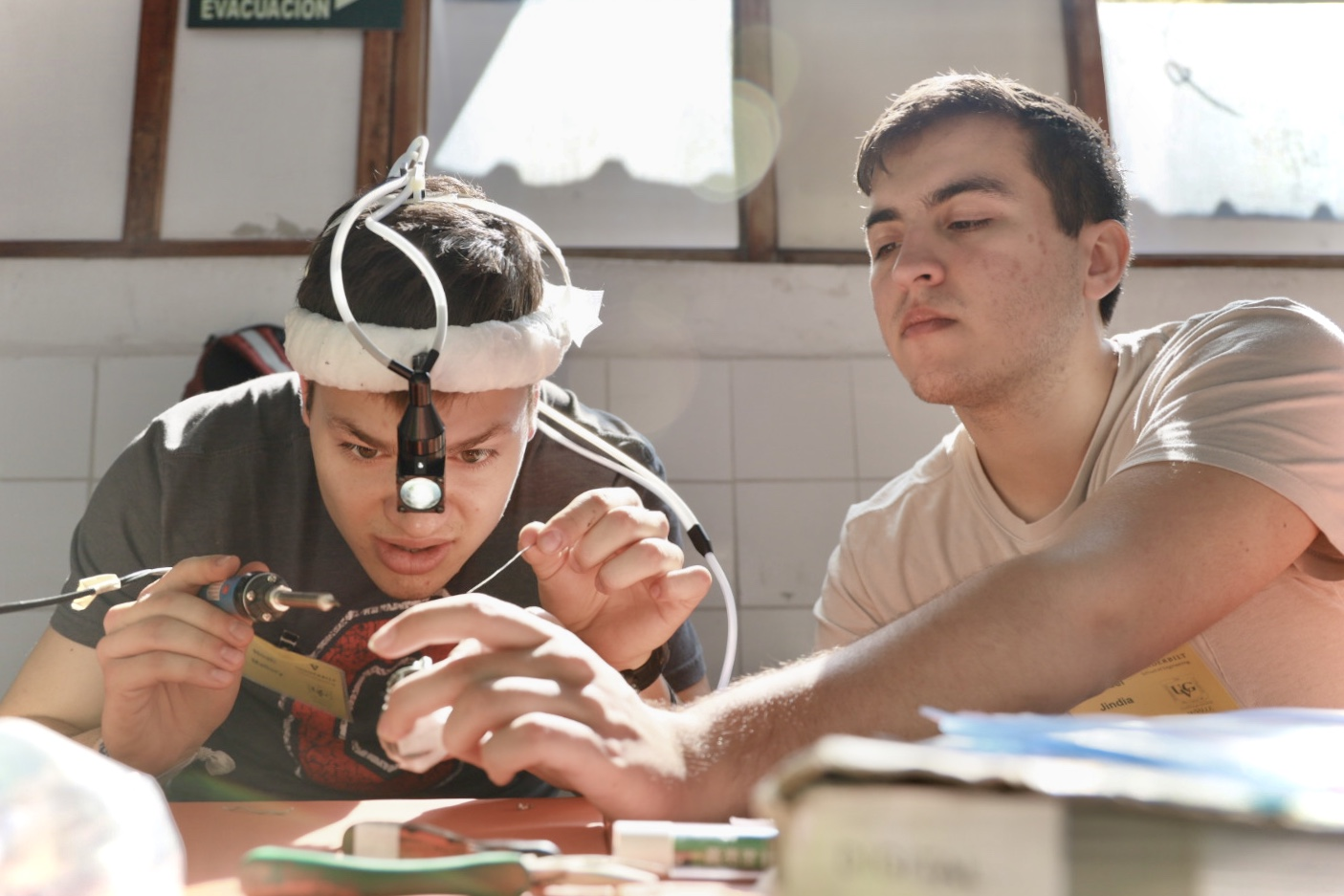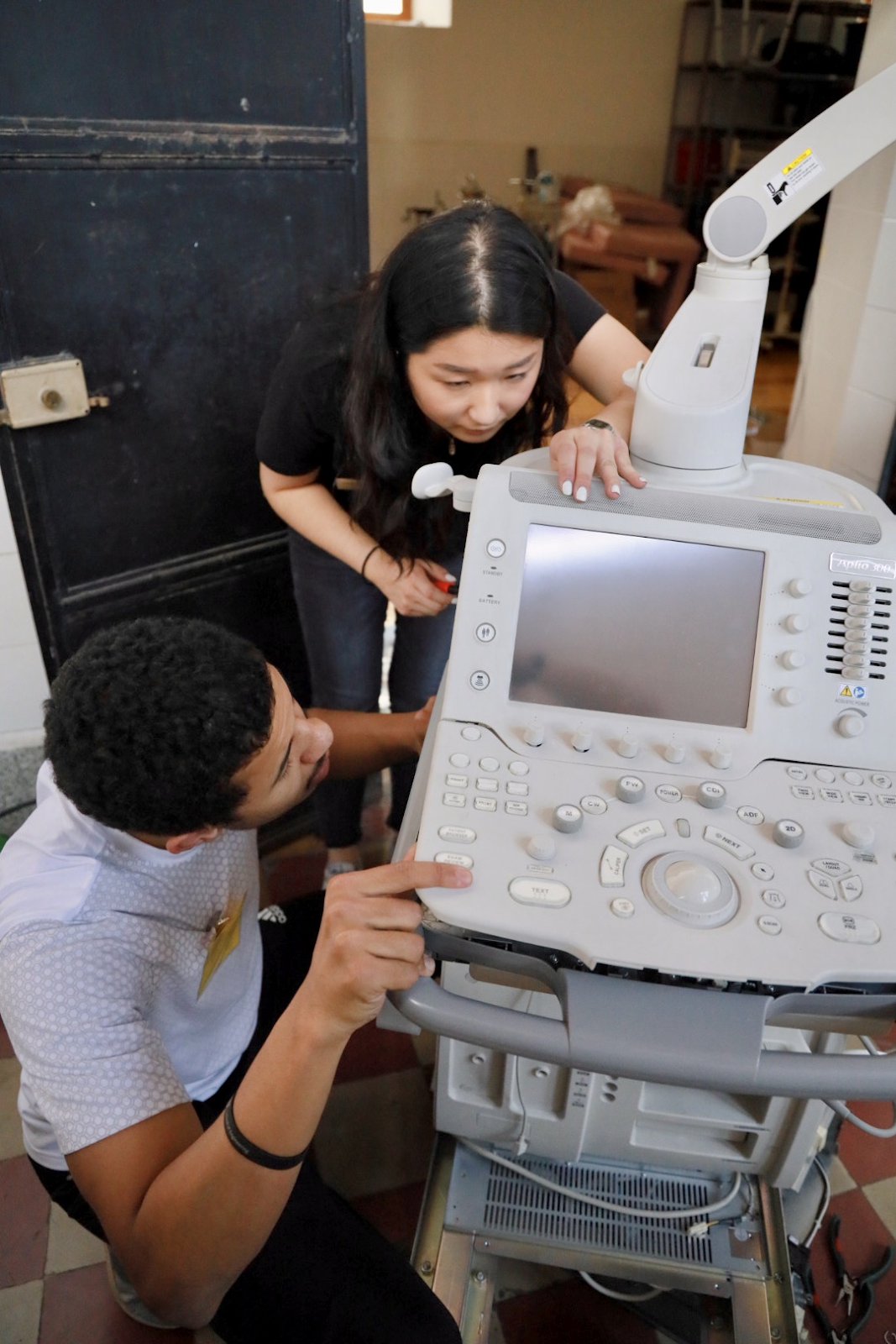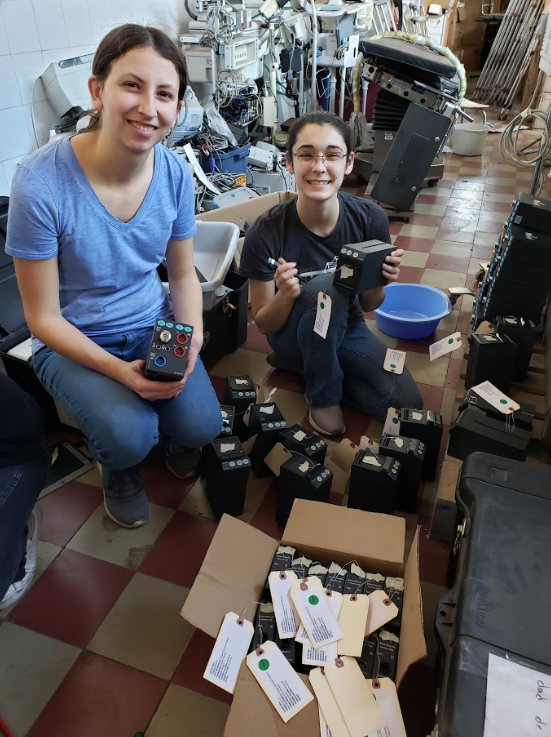 |
| Our runners braving the cobblestone streets of Antigua |
Our group of runners jumped from sidewalk to sidewalk in the predawn, spending as little time on the risky cobblestone streets as possible. Street light illuminated las calles of Antigua. Most of us were in the jogging group, a few in the walking group, and a couple had decided to stay at Casa Mia Hotel. The majority of us were headed towards the scenic hill called Cerro de la Cruz. We heaved and puffed as we climbed to the top from whence we could see all of Antigua and three volcanoes spread before us. While on the top of the hill, Volcan de Fuego gave us a performance, spouting smoke and fire from across the valley. We took in the sunrise and the incredible view before heading back towards the hotel to begin the day.
 |
| At the top of Cerro de la Cruz with Volcan de Agua in the background |
 |
| Swinging on the playground at Casa Mia |
Breakfast at the hotel was a chance to discuss our journal questions from the day before while enjoying a breakfast of huevos and plantains. The conversation and coffee woke us up, preparing us for the day of concentration ahead. Today, we were close enough to Obras Sociales del Hermano Pedro to grab our bags and walk our ten tool bags to the hospital. The brisk morning air, vibrantly colored buildings, and Guatemalans hurrying to begin their days filled us with energy and excitement for this incredible city and people. We arrived at Hermano Pedro, refreshed and ready to work.
 Unwilling to admit defeat, Michael and Noah picked up the defective foot pedal from yesterday to give it another shot.The wiring that allowed the cut function to work had completely come off its pin and broke apart. Consequently, Noah and Michael had to solder the wire back together and to the pin, which was buried in a narrow connector. As a result, they had to work in a space about as big as a water bottle cap. After many methods of approaching the problem of getting the wire to stick to the pin without connecting itself to the 3 other wires in the connector, all they had to show for it were burnt fingers and frustration. The sight of Michael and Noah wearing surgical light headsets and holding flashlights in their mouths to peer into the dark crevice was quite comical for the others as they failed time and time again. Finally, after 2 hours, Michael came up with quite an ingenious plan: to spiral solder wire within a heat shrink and solder the wire and pin together. Michael says he’s never felt a sense of accomplishment in his engineering career that comes close to this “jank fix.”
Unwilling to admit defeat, Michael and Noah picked up the defective foot pedal from yesterday to give it another shot.The wiring that allowed the cut function to work had completely come off its pin and broke apart. Consequently, Noah and Michael had to solder the wire back together and to the pin, which was buried in a narrow connector. As a result, they had to work in a space about as big as a water bottle cap. After many methods of approaching the problem of getting the wire to stick to the pin without connecting itself to the 3 other wires in the connector, all they had to show for it were burnt fingers and frustration. The sight of Michael and Noah wearing surgical light headsets and holding flashlights in their mouths to peer into the dark crevice was quite comical for the others as they failed time and time again. Finally, after 2 hours, Michael came up with quite an ingenious plan: to spiral solder wire within a heat shrink and solder the wire and pin together. Michael says he’s never felt a sense of accomplishment in his engineering career that comes close to this “jank fix.”
 |
Cerie and Antonio with their
formidable opponent |
Cerie and Antonio took on the challenge of attempting to repair perhaps the most complicated piece of equipment they’ve worked on so far -- an advanced ultrasound system. This ultrasound unit was a formidable challenge, weighing in at around 125 kilograms. The device failed to power on when plugged in, and the two opened up the machine for breaks, blown fuses, overheated components, or literally any other malady. Unfortunately, the ultrasound unit led them down rabbit hole after rabbit hole, eventually requiring Cerie and Antonio to practically remove around 100 screws and disassemble the entire device to seek out the root of the power problem. Sadly, they had to pack up for the day and could not fix the ultrasound system. However, they had a great opportunity to learn about ultrasound systems and got a great workout in dismantling this giant and complex machine.
 |
| Stephanie and Katie's masses of modules |
While Cerie and Antonio were busy working on the ultrasound, Katie and Stephanie tackled an enormous collection of anesthesia machine monitors and modules. Saying these devices were everywhere is not an exaggeration; modules were found sitting on towers, scattered about shelves, and hiding in boxes. The team started by centralizing and sorting the hospital’s collection, after which Katie and Stephanie began testing SPO2 and NIBP/ECG modules, respectively. After measuring their own pulse rates and blood pressures countless times, a grand total of 51 vital signs, pulse oximetry, and printer modules were tested, cleaned, and inventoried! Special props to Stephanie, who sacrificed her arm's blood flow to over 15 blood pressure tests. A set of working modules was then added to each of the cases corresponding to the three viable screens, creating three monitoring sets ready for use! The greatest challenge of this project was probably finding the right ancillaries: each new module required a (sometimes frustrating) hunt for the correct connector, but almost all of them were found in the end. The hospital owns a vast, largely unsorted collection of cords and cables for the monitors: perhaps a project for the next trip?
 |
| Zach fixing a drill at Obras Sociales |
Dinner was incredible. We went to La Estancia where we met Dr. P’s Spanish teacher Clara and Dr. Adams led us onto the plant-covered roof of the restaurant. The Guatemalan food did not disappoint. Some groups ordered their own meals while on group pitched in all together to create a smorgasbord of meats which they passed around family-style. With room only for ice cream, most of the group headed to the central Antigua Square where they filled in all the cracks with Guatemalan ice cream. Stuffed, everyone headed through the still lively streets to the hotel for an evening of reflection and games.
No comments:
Post a Comment